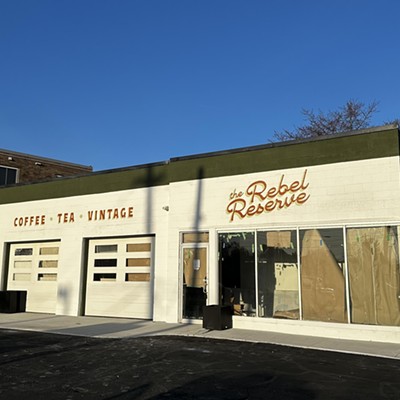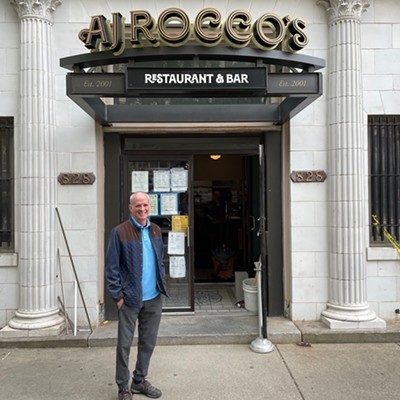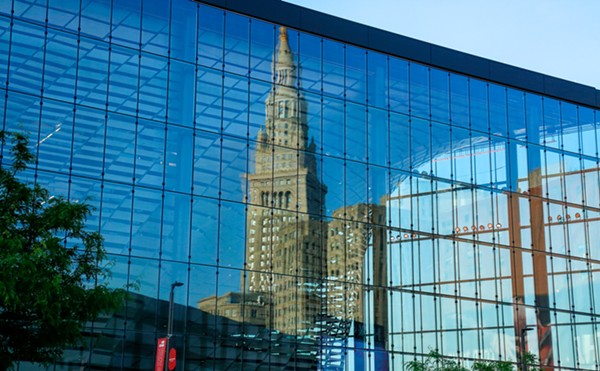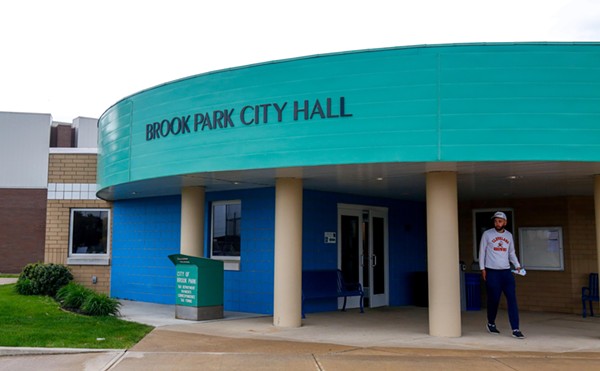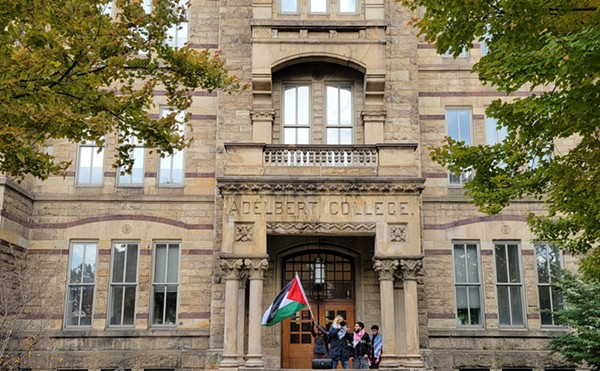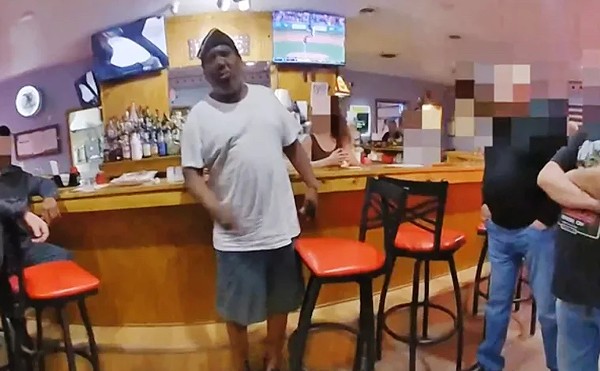On an isolated strip of Prospect Avenue just east of the Inner Belt, a short row of storefronts is aglow on an otherwise sleepy Friday evening. Defying the nighttime desertion on the fringes of downtown, the William Busta Gallery is packed with visitors checking out recent work by some of the region's most gifted artists.
Opening tonight is Monsters and Ghosts, a set of unsettling collages that explore the theme of violence. They're the creations of respected Cleveland painter Dexter Davis, a graduate of the Cleveland Institute of Art. It's his first show in nine years.
Adjoining rooms contain pieces by several other renowned Northeast Ohio artists: the surreal urban landscapes of Timothy Callaghan, Kristen Cliffel's playfully ornate ceramic pieces, Kent State professor Paul O'Keeffe's vivid constructions that resemble cryptic playground equipment. They've all been celebrated at Busta in recent months, but these days their works linger where in years past they would be all but forgotten by now. That's because Busta's showplace is three times its former size.
Gallery owners from Lakewood to Collinwood are well acquainted with the often sobering realities of their trade: Even in the best of economic times, galleries tend to be risky business. They are generally run by hobbyists or young artists whose love of art eclipses their business acumen. The list runs long of galleries that have appeared and disappeared as the "hot" art neighborhoods shifted: from pioneering Little Italy to Euclid Avenue downtown, and from Tremont to the "Art Quarter" of Superior-St. Clair.
But while recession has taken its toll on many of them, a handful of galleries are enjoying boom periods the local art world hasn't seen in years: larger crowds, brisker sales — and a shared need to expand their space to accommodate the growth. And though the type of work they show and the clients they do business with varies, they are united in their passion for exalting the work of Cleveland's top artists. Their dedication is paying off for both sides.
"This is a big adventure," William Busta says with a whiff of satisfaction. "I do know the audience loves it. They are excited to come here."
Throughout the 1990s, Busta's gallery in Little Italy was a safe house for commingling creatives, and it played a key role in forging the reputations of local artists like Davis, charcoal artist Laurence Channing, and Derek Hess, whom Busta helped transition from rock poster maker to nationally acclaimed fine artist.
Busta stepped away from gallery ownership for several years, but returned in 2007 to a narrow, ground-floor space on Prospect. Late last year, as shows by topnotch local artists like painter Matthew Kolodziej and textile artist Hildur Asgeirsdottir Jonsson attracted large crowds, and driven by his desire to display his featured artists' work more continuously, Busta expanded from one storefront to three. The gallery now boasts 4,500 square feet and a series of rooms, each devoted to the work of a different artist.
"I wanted different kinds of challenges," he says. "Instead of group shows, it's like a series of shows of [each] artist in more depth. If people didn't get to come to a show, I have a smaller version of the show up."
Keeping a backlog of work on hand increases Busta's sales potential, he says. "There's enough work on the walls now that people are telling friends, 'If you want to buy something, stop by Busta's. He has a lot of stuff.'"
Artists are finding the same holds true with fans of their work.
"It's nice to be able to have some things out," says ceramacist Kristen Cliffel. "People are constantly saying, 'I had no idea of the scale of your work looking at your website.' With multi-dimensional, multi-surface work like mine, a picture on a postcard doesn't do it justice. Now I can tell people I have work at the gallery and meet them there."
On another recent Friday, a crowd has gathered in a small storefront several miles away in Cleveland Heights. At Heights Arts Gallery, the walls are lined with framed work by Jake Kelly and John G, two of the area's most gifted rock & roll poster artists. A freestanding wall in the center of the room is plastered with their fliers.
Like Busta, Heights Arts is dedicated to showcasing the work of Northeast Ohio's best-known artists — a mission that dates to the group's inception in 2000.
"No one was regularly showing local artists," recalls director Peggy Spaeth. "So many people were saying that Cleveland artists had to go to New York to be appreciated."
Spaeth uses the example of Brent Kee Young, head of the ceramics department at the Cleveland Institute of Art. "She's in museums all over the world, but many people didn't know she was here. We're trying to bring the finest regional artists so people would know what treasures we have here.
"Ten years later, it's gratifying that people come to the gallery and know the artists we show."
And ten years later, the nonprofit gallery has shrugged off the bite of recession by orchestrating a major expansion of its own.
With the acquisition of a former Starbucks and restaurant next-door on Lee Road, the gallery will nearly double its space to 2,400 square feet. Plans call for construction to unite the two spaces in May, followed by a grand reopening in June.
More than just an art gallery, the added room will accommodate classes, concerts, literary readings — even theatrical productions. And like Busta, Spaeth looks forward to being able to feature work by artists even after their shows have closed. With the nonprofit's state funds likely to dry up in the near future, the ability to showcase more art for sale took on greater importance.
"What I've learned over ten years is that a nonprofit is a small business," says Spaeth. "You have to not only ask for money, but to make money." So far, that's exactly what's happening.
"Our sales have increased every year," she says. "We get people here all the time who say they'd rather shop here than a chain store because it helps local artists and the local economy."
East Side art dealer and historian Bill Tregoning had spent 13 years running his namesake gallery in tony Chagrin Falls. His modest 1,300-square foot shop was a destination for a high-end clientele looking for quality work to hang over some very expensive sofas — much of it by the early-20th-century Cleveland School masters he specialized in.
But in 2007, Tregoning moved to a 5,000-square foot space in the former American Greetings building at West 78th Street, on the edge of the Gordon Square Arts District. The place has quickly blossomed into a bustling arts colony, with 11 galleries and a surplus of youthful energy.
"It is in a great location, and it's a great engine for economic change," Tregoning says.
He estimates that 3,500 people visited his Chagrin gallery in more than a dozen years. "In three and a half years, I've had 9,300 come through this gallery," he says, in part thanks to coordinated events like Third Fridays and Gordon Square art walks, recurring events that draw crowds to the neighborhood. "It is an unbridled, absolute success."
Last summer, Tregoning & Co. hosted the most extensive show ever devoted to the late George Adomeit, a Cleveland painter whose post-impressionist landscapes often depicted Northeast Ohio scenes. The coveted red dots that indicate a sold work popped up throughout the gallery.
Tregoning's move has offered the chance to reach beyond his select audience of traditional collectors. "We have people from their 30s to their 80s," he says. "I have active collectors in every generation. I have young people putting $100 a month to buy something. I've helped with six or seven collections that didn't exist a few years ago. This marvelous space of mine has given me all sorts of opportunities that I felt hamstrung to do out in Vanillaville."
With the move came a shift in focus to living artists rather than those who were safely dead. At the Chagrin Falls gallery, he says, "I didn't feel that I could necessarily do for living artists what other people seem to do very well. I needed to be proven wrong. I realized I have gifts working on behalf of people I'm enthusiastic about, and whose work and vision I respect."
Now he specializes in what he describes as "major Cleveland artists at mid-career" whom he feels could use a little more momentum. Currently he's showing new mixed-media assemblages by Chris Pekoc, winner of a prestigious Cleveland Arts Prize in 2007.
Pekoc says Tregoning was one of the first people to buy his work back in the '70s. But in Chagrin Falls, Tregoning was unable to display a large enough range of work to give collectors a sufficient grounding in Pekoc's evolving style. It's why the two never worked together until now.
"His move has been great for people like me," says Pekoc. "He's much more visible, and he's impacted my visibility. He's held some private events in the gallery where the invitation list was handpicked. For one event, he invited 60 people to dinner in the gallery, and I was able to give a talk about work I did in the '80s."
Artists like Pekoc — or Brent Kee Young or Dexter Davis — may not attract overheated prices in art centers like New York, even if they are every bit as talented. Busta believes buying and selling art is ultimately a local business, where the personal taste of a knowledgeable gallery owner — and the opportunity for patrons to interact with artists — turns viewers into purchasers. And familiarity breeds business, he says.
"I think art becomes richer when you are able to see the work of an artist over time," says Busta. "You get to know what artists are doing, how they are developing, what their last show was like. You're not buying just the one work of the artist, but the work you've already seen and the promise of work to come."


